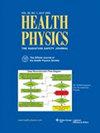Thresholds and mechanisms of retinal damage from a white-light laser.
IF 1
4区 医学
Q4 ENVIRONMENTAL SCIENCES
引用次数: 6
Abstract
Rhesus monkey retinae* were exposed to single 300-nsec pulses of light from a new dye-laser system, which produces a white-light effect by the simultaneous, coaxial generation of 480-, 508-, 528and 595-nm wavelengths. EDso values (i.e. the dose that has a 50% probability of producing minimum ophthalmoscopically visible damage) for 1and 24-hr post exposure examinations were, respectively, 3.9 and 2.7 pJ total intraocular energy. These EDso values are similar to single-wavelength exposures of comparable pulse duration.白光激光视网膜损伤的阈值和机制。
本文章由计算机程序翻译,如有差异,请以英文原文为准。
求助全文
约1分钟内获得全文
求助全文
来源期刊

Health physics
医学-公共卫生、环境卫生与职业卫生
CiteScore
4.20
自引率
0.00%
发文量
324
审稿时长
3-8 weeks
期刊介绍:
Health Physics, first published in 1958, provides the latest research to a wide variety of radiation safety professionals including health physicists, nuclear chemists, medical physicists, and radiation safety officers with interests in nuclear and radiation science. The Journal allows professionals in these and other disciplines in science and engineering to stay on the cutting edge of scientific and technological advances in the field of radiation safety. The Journal publishes original papers, technical notes, articles on advances in practical applications, editorials, and correspondence. Journal articles report on the latest findings in theoretical, practical, and applied disciplines of epidemiology and radiation effects, radiation biology and radiation science, radiation ecology, and related fields.
 求助内容:
求助内容: 应助结果提醒方式:
应助结果提醒方式:


